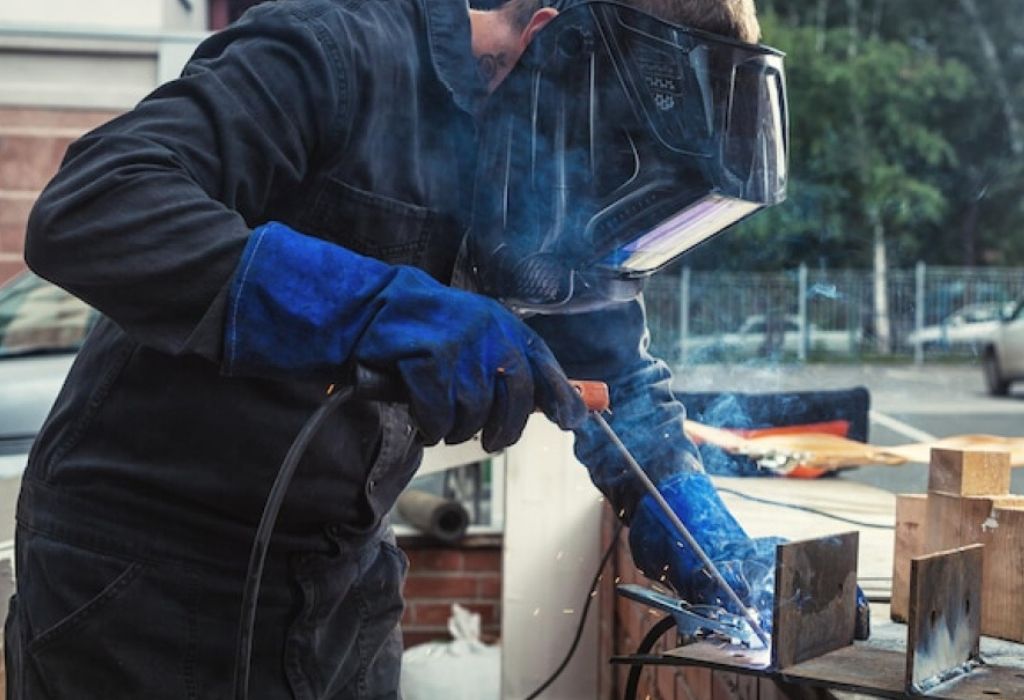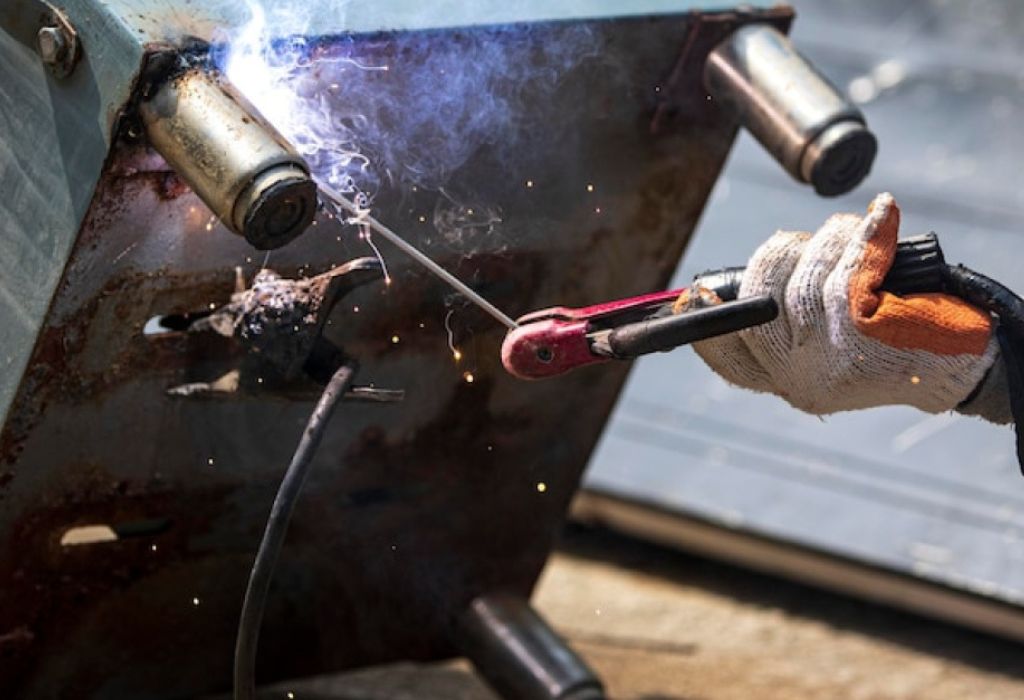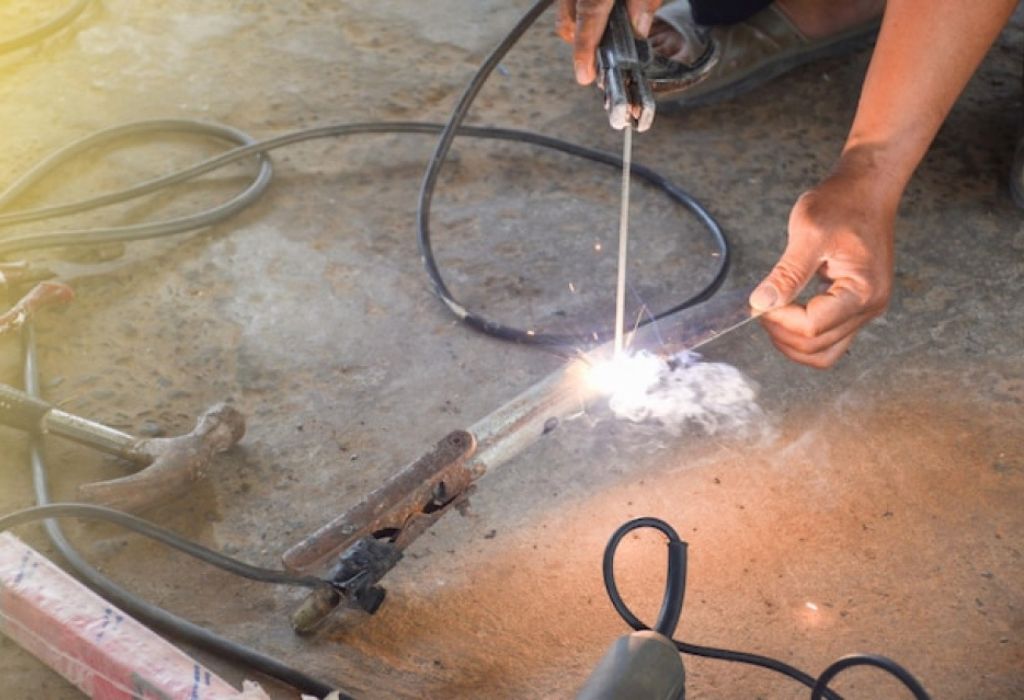A sudden storm hits a construction site. The crew rushes to cover their tools, but one welder hesitates—his machine is still connected and sitting in the rain.
He wonders: can a welding machine get wet, or will it survive until the clouds pass?
Moisture and electricity are a dangerous mix. Even small amounts of water can create a conductive path that leads to electric shock, circuit failure, or fire. According to the U.S. Bureau of Labor Statistics, electrical incidents account for about 5% of all workplace fatalities in construction each year (source).
The risks multiply when welders work in outdoor or humid conditions.
This guide explains exactly what happens when a welding machine gets wet, how moisture affects components, and what every professional or DIY welder must do to stay safe in rainy or damp environments.
Can a Welding Machine Get Wet? (Short Answer)

No — a welding machine should never get wet. Welding equipment is designed for controlled, dry conditions. Water exposure increases the chance of electric shock, short circuits, and permanent damage to internal components.
Even small amounts of moisture can bypass insulation and flow through conductive paths inside the machine. Unless specifically rated for outdoor use, welders must always be protected from rain, humidity, and puddles.
Can a welder run in light rain?
Not safely. Water on cables or casings can conduct electricity to the user.
Are waterproof welders available?
Some engine-driven models have weather-resistant housings, but “waterproof” is misleading—keep them dry whenever possible.
Does rain damage electronics instantly?
If water reaches live circuits, yes. Even condensation can trigger a short.
Will a VRD protect me if the welder gets wet?
Voltage Reduction Devices lower open-circuit voltage but cannot prevent shock from direct moisture contact.
Can a welder be used under a shelter during rain?
Yes, if the unit and cables remain completely dry and the shelter is non-conductive with proper ventilation.
How Moisture Damages Welding Machines
Electricity naturally seeks the easiest path to ground. When water enters a welding machine, it provides that path—often through metal panels, coils, or even the operator’s body.
Moisture causes two main problems: short circuits and corrosion. Short circuits occur when current jumps across wet surfaces instead of following insulated paths. Over time, moisture corrodes internal parts like transformers, circuit boards, and switches, leading to unstable output and premature failure.
What part fails first when wet?
Control boards and connection terminals corrode quickly once exposed.
Can moisture cause false readings?
Yes. Damp sensors or resistors alter voltage feedback, causing erratic output.
Does drying fix corrosion damage?
Not always. Rust or oxidation may permanently degrade conductivity.
How does condensation form inside?
Warm electronics meeting cool, humid air pull moisture into the case.
Can saltwater exposure ruin a welder?
Almost always—it’s highly conductive and accelerates corrosion.
Understanding Safety Ratings: IP and NEMA Codes
Every welding machine has an enclosure rating showing how well it resists dust and moisture.
European standards use IP ratings (Ingress Protection), while North American products often list NEMA ratings.
For example, IP23 means protection from limited water spray, while NEMA 3R or 4 enclosures resist light rain but not immersion. These ratings apply only to the casing, not to cables or connectors—so overall system safety still depends on proper setup.
Where can I find my welder’s rating?
Check the nameplate or manufacturer manual.
Is IP23 safe in rain?
Only for short, light exposure—always keep it under cover.
Does a higher IP rating mean waterproof?
No. It means more resistance to splashes, not total water sealing.
What’s better, IP or NEMA?
Both serve the same purpose—just different regional standards.
Can I upgrade protection myself?
Yes, with weatherproof covers or enclosures, but never block cooling vents.
Outdoor Welding Safety in Wet or Humid Conditions
Outdoor welding is common in shipyards, pipelines, and construction sites. But even when weather changes suddenly, welders must control their environment to prevent accidents.
Keep the welding machine elevated on a dry surface like a wood pallet or rubber mat.
Use canopies or welding tents that block rain but allow airflow. Always dry gloves and clothing before touching the machine or workpiece.
Can I weld in rain with GFCI protection?
A GFCI helps, but it doesn’t make wet welding safe—avoid standing water at all costs.
Should the welder sit on the ground?
Never. Elevate it to avoid splashes and puddles.
Does humidity alone cause problems?
Yes, condensation builds up inside electronics even without visible water.
Can engine-driven welders run in the rain?
Yes, if sheltered and kept dry—protect control panels and vents.
What footwear should I use outdoors?
Wear EH-rated rubber-soled boots that resist electrical conduction.
Leads, Cables, and Connectors—Hidden Moisture Hazards

Even if the machine stays dry, moisture on cables and connectors can create dangerous leakage currents. Frayed insulation, cracked plugs, or taped joints act like open doors for electricity.
Keep all connectors tight, insulated, and away from puddles. Route cables with drip loops so water runs off instead of toward the machine. Replace worn leads immediately—never rely on tape or makeshift fixes.
Why does my welder trip the breaker when wet?
Leakage current from damp cables causes ground faults.
Is it safe to coil wet leads?
No. Coils trap heat and water, increasing risk.
Can I use plastic bags over connectors?
Only temporarily and loosely—airflow is necessary to prevent condensation.
Do longer cables increase risk?
Yes—more surface area for moisture and higher resistance.
What’s the best prevention tip?
Inspect leads before every job and store them dry and coiled loosely.
Power Sources, Generators, and Extension Cords
When working outdoors, many welders rely on portable generators or long extension cords. Both need special attention in wet conditions.
Use outdoor-rated cords with intact jackets and correct gauge for current draw. Plug welders into GFCI-protected outlets, and ensure the generator’s frame is properly grounded per NEC 250. Avoid unshielded power strips or adapters.
Can generators run in the rain?
Only under waterproof shelters with open sides for ventilation.
Why does my GFCI trip instantly?
Water intrusion or damaged cables are likely.
What gauge cord should I use?
10- or 12-gauge for 120 V welders; thicker for 240 V.
Can inverter welders run on small generators?
Yes, but ensure <5% THD and adequate wattage.
Is bonding to ground rod necessary?
Follow the generator manual and local electrical codes.
What to Do if a Welding Machine Gets Wet
If your welder is accidentally exposed to water, do not power it on. Electricity and residual moisture can cause severe shock or destroy components.
Unplug the unit immediately and move it to a dry, ventilated space. Remove covers only if trained or authorized. Use gentle airflow (not heat guns) and let it dry for at least 24–48 hours before testing. For expensive machines, have an electrician perform an insulation resistance test.
Can I just wipe it dry and use it?
No—internal moisture may remain. Wait and inspect thoroughly.
What if water entered the vents?
Open the casing for airflow; never power it until fully dry.
Should I use rice or heat lamps?
Avoid overheating plastics; use ambient warm air instead.
Can saltwater-exposed welders be repaired?
Possibly, but they require full cleaning and component replacement.
When to call a technician?
If display lights flash, breakers trip, or unusual noises appear after drying.
How to Identify Moisture Damage Symptoms
Even after drying, hidden corrosion or residue can create persistent faults. Recognize early warning signs before total failure.
Common symptoms include erratic arc output, tripping fuses, flickering displays, or GFCI activations. If the machine works one day and fails the next, moisture might be the unseen culprit.
Why does the arc sputter?
Wet or corroded terminals cause inconsistent current flow.
Why is there smoke or odor?
Moisture shorting across resistors or circuit boards.
Why does the fan run but no arc forms?
Output section or safety relay damaged by water.
Why is weld current too weak?
Corroded connections or partial short inside transformer.
Why do I get mild shocks from casing?
Leakage current through damp insulation—disconnect immediately.
Standards, Codes, and Manufacturer Warnings
Electrical safety standards make it clear: wet welding equipment violates most codes unless specifically rated and protected.
Relevant guidelines include OSHA 1910.254, NFPA 70E, and ANSI Z49.1 (Arc Welding Safety). These documents require keeping welding circuits and machines dry, using insulated mats, and stopping work during storms.
What does OSHA say about wet welding?
It prohibits energizing equipment in wet conditions without protective controls.
Do standards mention VRD?
Yes, VRDs help reduce idle voltage but are not substitutes for dry environments.
Are IP-rated welders code-compliant outdoors?
Only when installed and maintained per manufacturer specs.
Where can I read these standards?
At OSHA.gov, NFPA.org, and ANSI.org.
Are safety audits required?
Yes—periodic checks verify that outdoor electrical equipment remains compliant.
Preventing Water Damage—Proactive Measures
Prevention is far cheaper than repair. Simple habits keep your welder safe year-round.
Always store machines in dry areas, cover them during transport, and check surroundings before each job. Use rubber mats to isolate from wet concrete or metal floors. Regularly inspect cooling fans, cable insulation, and strain reliefs.
What’s the best cover for rainy days?
A ventilated waterproof canopy that doesn’t trap fumes.
Can I spray WD-40 inside for protection?
No—it can attract dust and cause arcing; use manufacturer-approved coatings.
Should I unplug after every shift?
Yes—prevents corrosion on contacts and stray voltage risks.
Do silica gel packs help?
Yes—place them in storage compartments to absorb humidity.
How often should I check connectors?
Before every outdoor job or monthly for shop machines.
Modern Safety Features That Help

New welding machines integrate smart electronics to reduce—but not eliminate—wet-condition hazards.
Features like GFCI outlets, VRD circuits, thermal sensors, and arc-force control improve safety margins. Some inverter welders include auto-shutoff systems that detect abnormal current leakage and power down instantly.
Does VRD work automatically?
Yes—it lowers open-circuit voltage when not welding.
Can smart welders sense moisture?
A few high-end models use humidity sensors for diagnostics.
What happens during overload?
Thermal cut-off activates, protecting internal boards.
Do these features replace PPE?
Never—use proper gloves, boots, and mats.
Can I retrofit safety add-ons?
Yes—install external GFCIs or surge protectors rated for welding load.
Future Innovations—Toward Water-Resistant Welding
The industry is developing tougher equipment for field conditions.
Next-generation inverters use nano-coated circuit boards, sealed connectors, and improved heat-sink designs that reduce humidity penetration.
Some companies experiment with IP54-rated mobile welders and battery-powered systems that isolate operators from mains current. Still, even these units need dry surroundings for reliable use.
Will future welders be fully waterproof?
Unlikely—cooling and air exchange always require venting.
Are battery welders safer in rain?
They remove mains risk but still short if water bridges terminals.
Can robotic welders work outdoors in rain?
Yes, inside sealed housings with environmental control.
Will coatings replace shelters?
They’ll help but won’t remove need for physical covers.
What’s the biggest upcoming change?
Smarter diagnostics that warn users before conditions become unsafe.
Conclusion
So, can a welding machine get wet? The answer is clear: absolutely not.
Even minor moisture exposure can lead to electric shock, arc instability, or complete machine failure.
Every welder—whether hobbyist or professional—must treat water as the ultimate enemy of electricity. Always keep machines elevated, covered, and connected through GFCI protection. Inspect cables, follow OSHA and NFPA standards, and never take shortcuts in wet environments.

I’m Darrell Julian, the founder, lead writer, and hands-on welding enthusiast behind ArcWeldingPro.com. With more than 15 years of real-world welding experience, I created this platform to share what I’ve learned in the field, in the shop, and in the heat of the arc.


